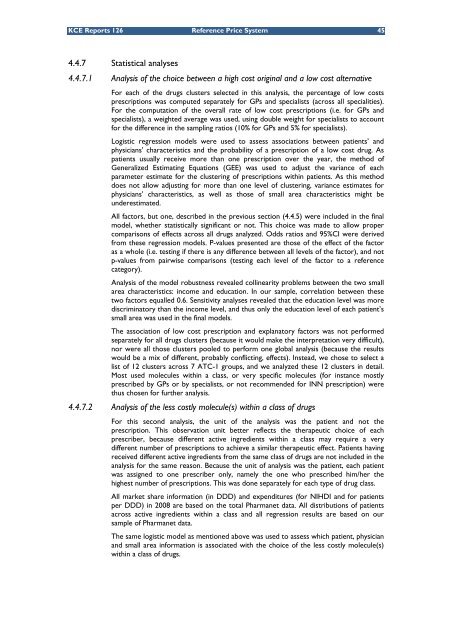The reference price system and socioeconomic differences in ... - KCE
The reference price system and socioeconomic differences in ... - KCE
The reference price system and socioeconomic differences in ... - KCE
You also want an ePaper? Increase the reach of your titles
YUMPU automatically turns print PDFs into web optimized ePapers that Google loves.
<strong>KCE</strong> Reports 126 Reference Price System 45<br />
4.4.7 Statistical analyses<br />
4.4.7.1 Analysis of the choice between a high cost orig<strong>in</strong>al <strong>and</strong> a low cost alternative<br />
For each of the drugs clusters selected <strong>in</strong> this analysis, the percentage of low costs<br />
prescriptions was computed separately for GPs <strong>and</strong> specialists (across all specialities).<br />
For the computation of the overall rate of low cost prescriptions (i.e. for GPs <strong>and</strong><br />
specialists), a weighted average was used, us<strong>in</strong>g double weight for specialists to account<br />
for the difference <strong>in</strong> the sampl<strong>in</strong>g ratios (10% for GPs <strong>and</strong> 5% for specialists).<br />
Logistic regression models were used to assess associations between patients’ <strong>and</strong><br />
physicians’ characteristics <strong>and</strong> the probability of a prescription of a low cost drug. As<br />
patients usually receive more than one prescription over the year, the method of<br />
Generalized Estimat<strong>in</strong>g Equations (GEE) was used to adjust the variance of each<br />
parameter estimate for the cluster<strong>in</strong>g of prescriptions with<strong>in</strong> patients. As this method<br />
does not allow adjust<strong>in</strong>g for more than one level of cluster<strong>in</strong>g, variance estimates for<br />
physicians’ characteristics, as well as those of small area characteristics might be<br />
underestimated.<br />
All factors, but one, described <strong>in</strong> the previous section (4.4.5) were <strong>in</strong>cluded <strong>in</strong> the f<strong>in</strong>al<br />
model, whether statistically significant or not. This choice was made to allow proper<br />
comparisons of effects across all drugs analyzed. Odds ratios <strong>and</strong> 95%CI were derived<br />
from these regression models. P-values presented are those of the effect of the factor<br />
as a whole (i.e. test<strong>in</strong>g if there is any difference between all levels of the factor), <strong>and</strong> not<br />
p-values from pairwise comparisons (test<strong>in</strong>g each level of the factor to a <strong>reference</strong><br />
category).<br />
Analysis of the model robustness revealed coll<strong>in</strong>earity problems between the two small<br />
area characteristics: <strong>in</strong>come <strong>and</strong> education. In our sample, correlation between these<br />
two factors equalled 0.6. Sensitivity analyses revealed that the education level was more<br />
discrim<strong>in</strong>atory than the <strong>in</strong>come level, <strong>and</strong> thus only the education level of each patient’s<br />
small area was used <strong>in</strong> the f<strong>in</strong>al models.<br />
<strong>The</strong> association of low cost prescription <strong>and</strong> explanatory factors was not performed<br />
separately for all drugs clusters (because it would make the <strong>in</strong>terpretation very difficult),<br />
nor were all those clusters pooled to perform one global analysis (because the results<br />
would be a mix of different, probably conflict<strong>in</strong>g, effects). Instead, we chose to select a<br />
list of 12 clusters across 7 ATC-1 groups, <strong>and</strong> we analyzed these 12 clusters <strong>in</strong> detail.<br />
Most used molecules with<strong>in</strong> a class, or very specific molecules (for <strong>in</strong>stance mostly<br />
prescribed by GPs or by specialists, or not recommended for INN prescription) were<br />
thus chosen for further analysis.<br />
4.4.7.2 Analysis of the less costly molecule(s) with<strong>in</strong> a class of drugs<br />
For this second analysis, the unit of the analysis was the patient <strong>and</strong> not the<br />
prescription. This observation unit better reflects the therapeutic choice of each<br />
prescriber, because different active <strong>in</strong>gredients with<strong>in</strong> a class may require a very<br />
different number of prescriptions to achieve a similar therapeutic effect. Patients hav<strong>in</strong>g<br />
received different active <strong>in</strong>gredients from the same class of drugs are not <strong>in</strong>cluded <strong>in</strong> the<br />
analysis for the same reason. Because the unit of analysis was the patient, each patient<br />
was assigned to one prescriber only, namely the one who prescribed him/her the<br />
highest number of prescriptions. This was done separately for each type of drug class.<br />
All market share <strong>in</strong>formation (<strong>in</strong> DDD) <strong>and</strong> expenditures (for NIHDI <strong>and</strong> for patients<br />
per DDD) <strong>in</strong> 2008 are based on the total Pharmanet data. All distributions of patients<br />
across active <strong>in</strong>gredients with<strong>in</strong> a class <strong>and</strong> all regression results are based on our<br />
sample of Pharmanet data.<br />
<strong>The</strong> same logistic model as mentioned above was used to assess which patient, physician<br />
<strong>and</strong> small area <strong>in</strong>formation is associated with the choice of the less costly molecule(s)<br />
with<strong>in</strong> a class of drugs.
















